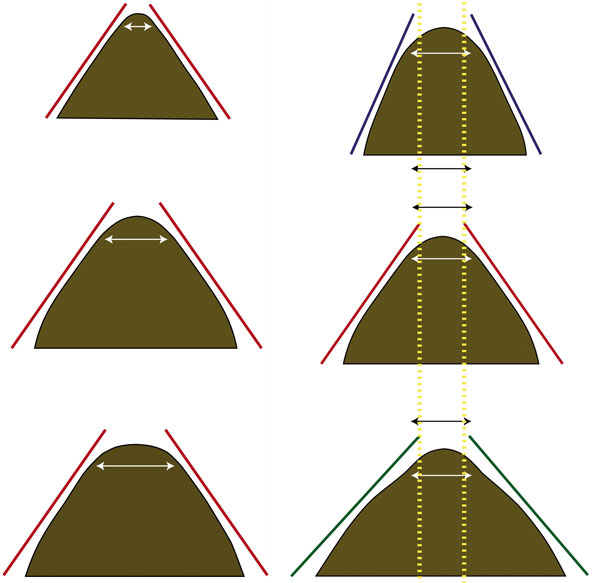
Left: These three diagrams illustrate identical tree angles with various tree widths.
Right: These three diagrams illustrate identical tree widths with different tree angles.
We’re down to the last two tips in my series of 9 Points of Saddle Fit. I have consolidated them because they work very much together. You really can’t have one without the other, which is something that many saddle manufacturers (especially those with ‘self-adjusting’ or DIY gullet plates really don’t seem to understand). These gullet plates will definitely change the angle, but unfortunately do not address the necessity of being able to accommodate the changes in width over the withers as well that are required for a proper fit.
Pretty much everyone riding is aware that trees come in narrow, medium, or wide, but these designations can refer both to the width of the tree (gullet plate) and to the angle. If your saddle is a “narrow wide,” this means it has a narrow tree angle with a wide tree width. This is the application you will see most often for a horse which has been well trained and is being ridden regularly – he has a wide barrel and the shoulders are up and back.
If the saddle does not stay behind the horse’s shoulder, and constantly moves forward because the width and angle are wrong for his conformation, the tree points of the saddle will drive into the horse’s shoulders, first producing a buildup of scar tissue on his scapula, and then chipping away cartilage and bone. This irreversible long-term damage can lead to persistent unsoundness and the premature retirement of the horse.
In order to avoid this kind of damage, it is crucial that the angle of the tree be adjusted to match the angle of the horse’s shoulder. Think of two sliding doors. If they are properly aligned, one will slide freely past the other. But if they are not, one will jam into the other. It is the same with your horse’s shoulders and the angle of his saddle’s tree. As the horse moves, his shoulder rotates upward and backwards. If the tree angle does not match the angle of the shoulders, they will be unable to rotate freely under the saddle, compromising movement. At the very least, a saddle with a tree angle that is not correctly adjusted is extremely uncomfortable for your horse. At worst, it can lead to irreversible long-term damage.
Determining Angle
We use the Sprenger gauge to measure the horse’s shoulder angle. It is put behind the shoulder blade, so that the upper arm of the device is parallel to the angle of the horse’s scapula. Read the full article here.
~ Jochen Schleese CMS, CSFT, CSE, courtesy of Saddlefit 4 Life
